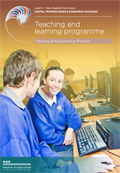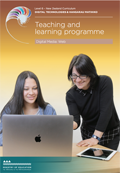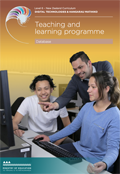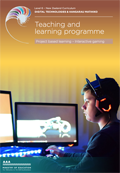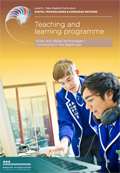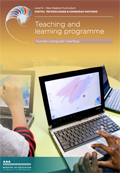New Zealand Curriculum Level 6 – NCEA Level 1
These teaching and learning programmes have been developed to support the new level 6 digital technologies curriculum. Developed by experienced digital technologies teachers, they are complete with resources, teacher notes, student work samples and assessment task/s. Teachers are encouraged to use and adapt these to suit the context of their own school communities. These programmes have been trialled in classrooms in 2018.
This teaching and learning programme is based around an eBook tutorial (flipped learning pedagogy) which includes embedded video. Students are given several problems related to games of chance and are encouraged to develop programs to solve these problems. No prior programming knowledge is assumed.
This programme uses the pedagogy of flipped learning. It is based around an eBook tutorial that includes embedded video. Students are provided with detailed instructions and walk-throughs showing how to create a fully functioning, refined website using HTML and CSS. No prior coding knowledge is assumed and all the software used is open source.
This programme is based on flipped learning pedagogy and uses an eBook tutorial that includes embedded video. Students are provided with detailed instructions and walk-throughs showing how to create a fully functioning, refined database and website using HTML, CSS, SQL, and PHP. It is assumed that students have previously completed teaching and learning on web (and/or completed the achievement standard 91880: Develop a digital media outcome) and are able to create basic HTML and CSS websites.
Teenagers love games. Being able to build their own game from the ground up is hugely motivating. There are many skills to be learning in being able to design and build a game. Using game development, students will be guided to use iterative development (with the option of using Agile Scrum methodologies) to develop a successful outcome
.
This themed, project-based learning programme asks students to create a game that will assist other students to learn about a myth or legend. Students work on various aspects of the project throughout the year, offering the possibility of collaborative work, but each outcome will be unique.
This programme focuses on developing an electronics outcome suitable for monitoring the environmental conditions of plants to enable plant health and survival. The programme is intentionally broad to cover a range of practical skills and theory relating to input and output interfaces. It covers the basics of microprocessors and software programming.
In this programme, students will learn to use a digital audio workstation (DAW) and virtual instruments to compose an original piece of music in response to a design brief. Students will create a design for their composition, considering the constraints of the brief, and then develop their composition using digital music production techniques.
Programme 8 – Human-computer interface - MODULE NO LONGER AVAILABLE
This programme is designed as interactive online learning modules to support students to complete a report that evaluates a human-computer interface in terms of usability heuristics. Classroom activities that could be used to supplement the modules are described in the teaching programme that accompanies this learning module.
Last updated December 16, 2024
TOP


